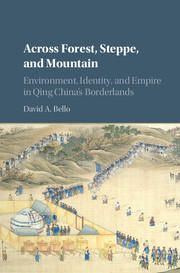Book contents
- Across Forest, Steppe, and Mountain
- Studies in Environment and History
- Across Forest, Steppe, and Mountain
- Copyright page
- Dedication
- Dedication
- Contents
- Tables
- Maps
- Notes on Translation and Transliteration
- Book part
- Introduction
- 1 Qing Fields in Theory and Practice
- 2 The Nature of Imperial Foraging in the SAH Basin
- 3 The Nature of Imperial Pastoralism in Southern Inner Mongolia
- 4 The Nature of Imperial Indigenism in Southwestern Yunnan
- 5 Borderland Hanspace in the Nineteenth Century
- 6 Qing Environmentality
- Works Cited
- Index
- References
Works Cited
Published online by Cambridge University Press: 05 February 2016
- Across Forest, Steppe, and Mountain
- Studies in Environment and History
- Across Forest, Steppe, and Mountain
- Copyright page
- Dedication
- Dedication
- Contents
- Tables
- Maps
- Notes on Translation and Transliteration
- Book part
- Introduction
- 1 Qing Fields in Theory and Practice
- 2 The Nature of Imperial Foraging in the SAH Basin
- 3 The Nature of Imperial Pastoralism in Southern Inner Mongolia
- 4 The Nature of Imperial Indigenism in Southwestern Yunnan
- 5 Borderland Hanspace in the Nineteenth Century
- 6 Qing Environmentality
- Works Cited
- Index
- References
- Type
- Chapter
- Information
- Across Forest, Steppe, and MountainEnvironment, Identity, and Empire in Qing China's Borderlands, pp. 277 - 320Publisher: Cambridge University PressPrint publication year: 2016



